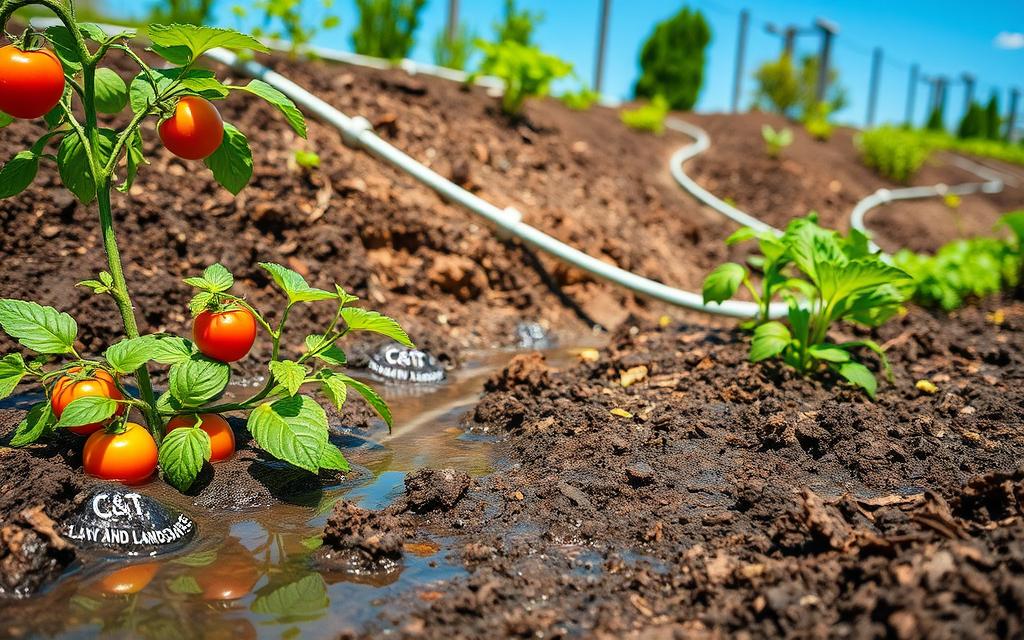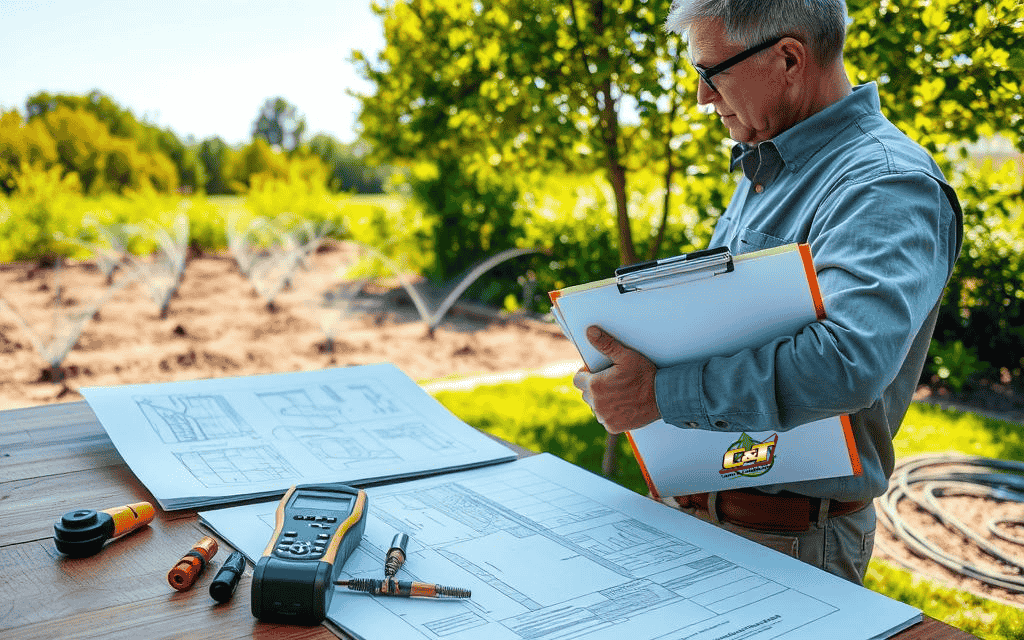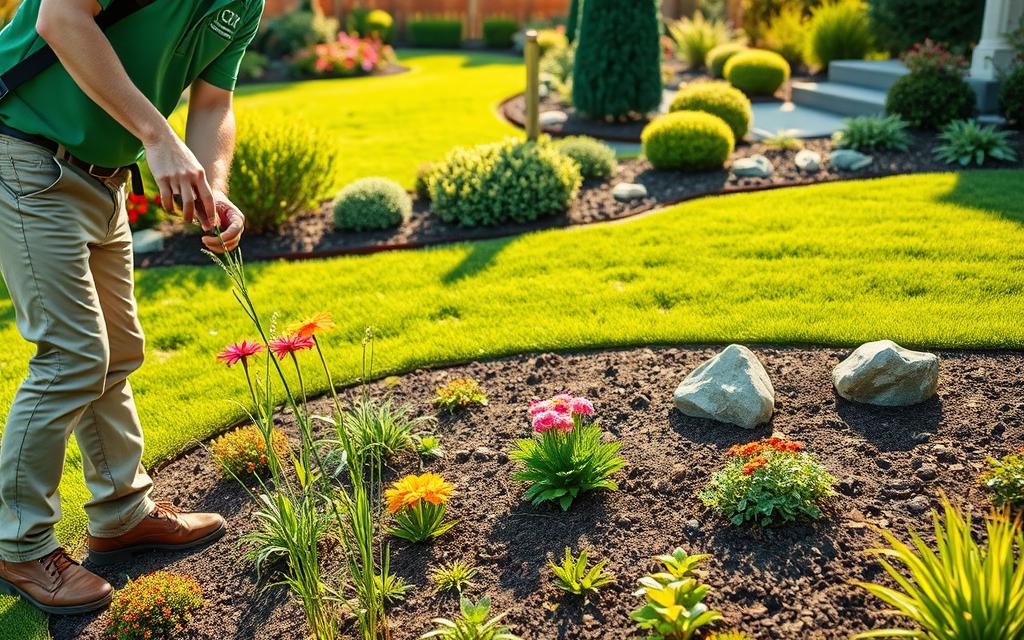Your lawn needs aeration when you spot key warning signs like thatch buildup over half an inch, water pooling after light rain, or patchy grass areas. Watch for compacted soil in high-traffic zones, especially if you can’t easily push a screwdriver into the ground. Clay-based soil, poor moisture retention, and stunted growth also signal it’s time to aerate. Understanding these indicators helps you maintain a healthier, more vibrant lawn through proper timing.
Thatch Layer Exceeds Half an Inch
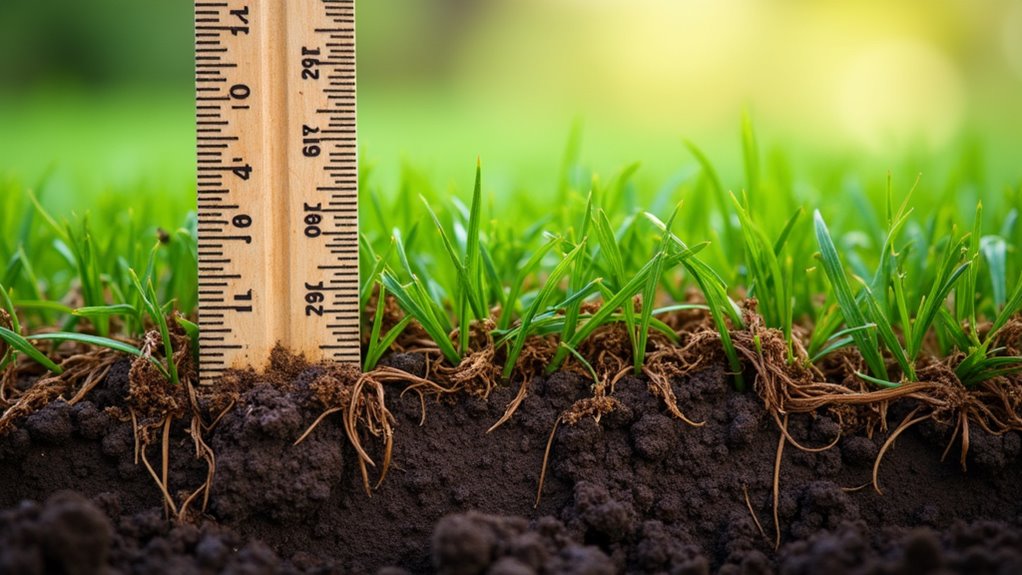
When your lawn’s thatch layer grows beyond half an inch thick, it’s time to ponder aeration as a crucial maintenance step. This excessive buildup creates a barrier between your soil and grass, preventing essential water, oxygen, and nutrients from reaching the roots. You’ll notice your lawn becoming less healthy as new grass struggles to grow through the compacted thatch.
Aeration offers an effective solution to break down this problematic layer. By creating holes in your lawn’s surface, you’re helping to accelerate thatch decomposition and restore proper resource flow to your grass roots. Don’t wait until your lawn shows severe signs of stress – check your thatch layer regularly by cutting a small wedge in your turf. If it’s thicker than half an inch, you’ll want to schedule aeration to maintain your lawn’s importance.
Visible Signs of Soil Compaction From Heavy Traffic
Your lawn’s traffic patterns tell a clear story about soil compaction. When you notice paths or play areas where grass has thinned or disappeared completely, that’s a clear sign that indicates your soil has become densely packed from heavy foot traffic. You’ll feel these compacted soil areas are harder underfoot compared to the rest of your lawn.
Look for visible ruts or depressions where repeated traffic has compressed the ground. If your grass appears yellowed or stunted in these high-traffic zones, it’s struggling because compacted soil prevents nutrients to reach the roots and blocks essential air and water flow. Try this simple test: if you can’t easily push a screwdriver into these areas, your lawn needs aeration to restore healthy soil structure and promote grass recovery.
Clay-Based Soil Structure
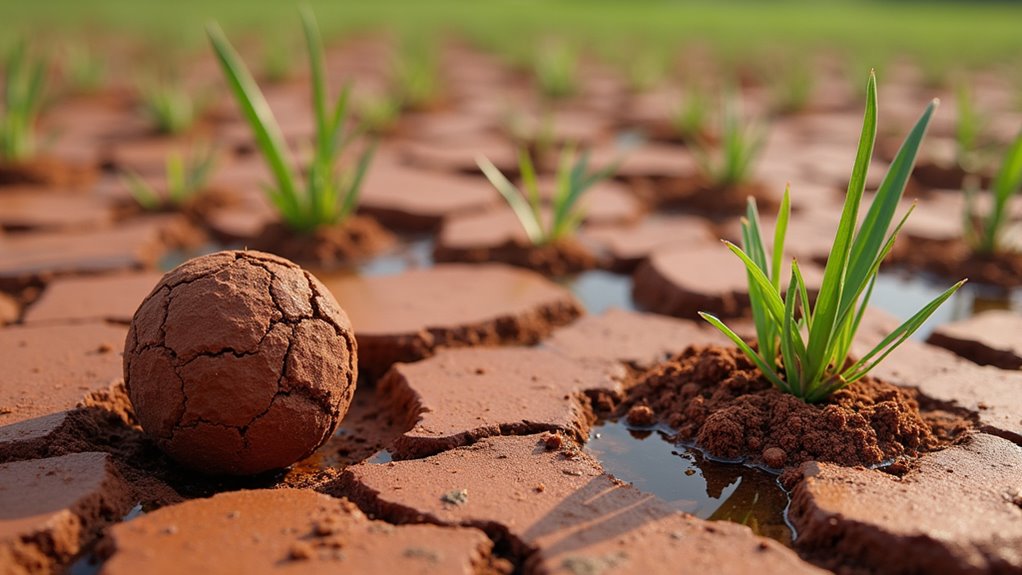
Your clay-based soil’s dense structure creates significant drainage problems that can leave your lawn waterlogged and struggling to thrive. These tightly packed clay deposits form barriers that restrict root growth, preventing your grass from developing the deep, healthy root system it needs. Through regular aeration, you’ll break up these problematic clay deposits, allowing water to flow more freely and giving your grass roots the space they need to grow stronger.
Dense Soil Drainage Issues
If you’ve noticed puddles lingering on your lawn after rain, clay-based soil is likely the culprit. Dense, compacted soil structure prevents proper drainage, causing water to pool on the surface instead of reaching the grass roots below. Your lawn’s health suffers when water and nutrients can’t move freely through the soil profile.
When clay soil becomes too compacted, it creates a barrier that restricts root growth and limits access to essential resources. Your grass roots stay shallow and weak, making them more vulnerable to stress and disease. To solve this problem, you’ll need to aerate your lawn regularly. This process breaks up the dense clay structure, creating pathways for water, air, and nutrients to reach the root zone. Better drainage means healthier grass and a more resilient lawn.
Breaking Up Clay Deposits
Breaking up stubborn clay deposits requires a systematic approach to restore your soil’s natural balance. If you’re dealing with clay soil, you’ll notice signs of compaction that affect your lawn’s health. Understanding these indicators helps you take action before problems worsen.
| Clay Soil Issue | Impact | Solution |
|---|---|---|
| Dense Structure | Poor water infiltration | Core aeration |
| Compaction | Limited root growth | Deep tining |
| Nutrient Lock | Reduced absorption | Regular aeration |
| Poor Drainage | Waterlogged grass | Seasonal treatment |
When clay particles bind tightly together, they create a barrier that restricts root zone development. You’ll need to focus on improving soil structure through strategic aeration. This process creates ideal pathways for water, air, and nutrients to reach grass roots. Regular maintenance prevents clay from reverting to its compacted state, ensuring your lawn maintains preferred drainage and growth conditions.
Root Growth Limitations
While healthy grass depends on strong root systems, clay-based soil structure presents significant challenges for ideal growth. Your lawn’s root development suffers when dense clay soil creates a barrier that prevents proper nutrient uptake and water absorption.
- Your grass roots can’t penetrate deeply through compacted clay soil, resulting in weak, shallow systems that struggle to anchor your lawn
- Water and nutrients become trapped in the dense clay structure, making them inaccessible to your grass roots
- Without proper air circulation, roots can’t breathe or expand, leading to stunted growth
- Clay soil compaction creates a hostile environment that prevents your lawn from developing the vigorous root system it needs
Regular aerating breaks up this restrictive clay soil structure, creating pathways for roots to grow deeper and access essential resources for a healthier lawn.
Water Pooling After Light Rain
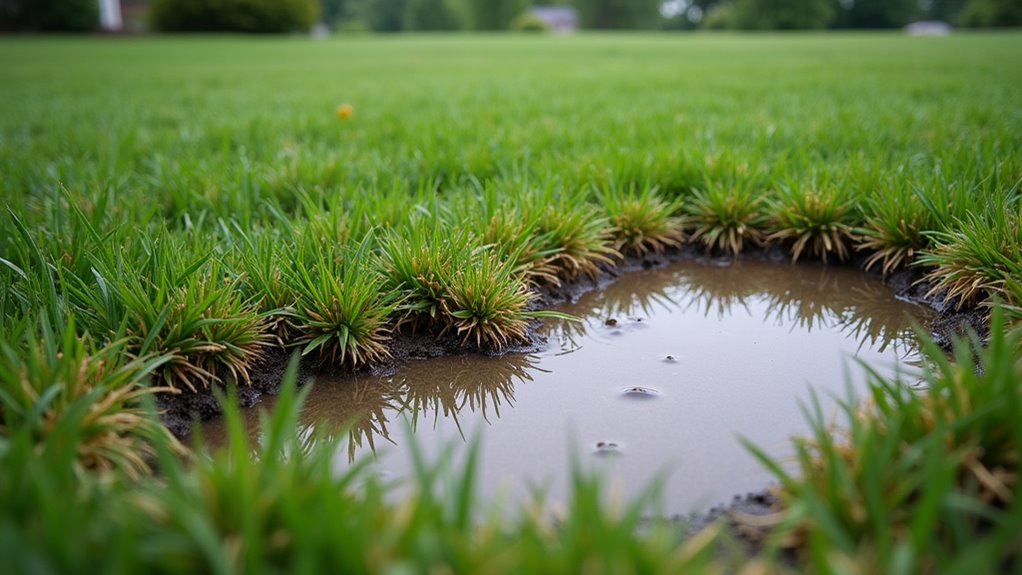
When your lawn retains puddles of water long after a light rainfall, you’re likely dealing with compacted soil that needs aeration. These standing water pools are clear signs your lawn needs immediate attention, as they indicate poor drainage that can harm your grass’s health. If you notice water pooling after even light precipitation, it’s one of the best indicators your lawn’s soil structure requires improvement.
Standing water doesn’t just look unsightly it creates perfect conditions for moss growth and lawn diseases to thrive. Aeration helps solve this problem by creating channels in the compacted soil, allowing water to properly infiltrate instead of collecting on the surface. When you spot these warning signs to look for, don’t wait to take action, as proper drainage is essential for maintaining a healthy, vibrant lawn.
Patchy and Thinning Grass Areas
Beyond water pooling issues, another clear indicator that your lawn needs aeration appears in the form of patchy and thinning grass areas. When you notice uneven growth and bare spots throughout your yard, soil compaction is likely the culprit. Compacted soil creates a barrier that prevents proper root growth and limits access to essential nutrients and water absorption.
- Your once-lush lawn starts showing scattered thin patches that won’t fill in despite regular care
- Grass becomes sparse in high-traffic areas where soil gets most compressed
- Bare spots appear and persist even with adequate watering and fertilization
- Previously healthy areas begin to deteriorate without obvious cause
Don’t let soil compaction compromise your lawn health. Aeration creates critical pathways in the soil, allowing grass roots to expand and access the resources they need for strong, uniform growth.
Yellow or Brown Discolored Spots
Have you noticed yellow or brown patches spreading across your once-vibrant lawn? These discolored spots are a clear sign your lawn needs aeration, as they often indicate that nutrients aren’t reaching your grass roots effectively. When soil becomes compacted, it creates a barrier that prevents your lawn from getting the indispensable elements it needs to maintain its healthy green color.
Don’t let these unsightly patches continue to spread. When your soil is compacted, grass roots can’t absorb nutrients more effectively, leading to widespread discoloration. Aeration is the solution you need to improve nutrient availability throughout your lawn. By creating small holes in the soil, aeration breaks up compacted areas and allows water, air, and crucial nutrients to penetrate deep into the root zone, helping restore your lawn’s uniform, healthy appearance.
Poor Moisture Retention
If you’re noticing dry patches in your lawn even after regular watering, compacted soil is likely preventing proper moisture absorption. Your lawn’s moisture retention problem becomes evident when water quickly runs off the surface instead of soaking into the soil, particularly in problem areas that seem to drain too fast. When your grass feels hard and concrete-like underfoot, it’s a clear sign that soil compaction is blocking water from reaching the roots, leading to frequent watering needs and inefficient water use.
Dry Patches Despite Watering
When your lawn shows persistent dry patches despite regular watering, it’s a clear signal that your soil isn’t properly absorbing moisture. Over time, compacted soil creates barriers that prevent water penetration, leaving your grass struggling to access the hydration it needs.
You’ll know it’s time to aerate your lawn when you notice these telling signs:
- Water pools on the surface instead of soaking into the soil
- Dry patches remain even after thorough irrigation
- Your lawn dries out faster than usual between waterings
- Grass looks stressed despite your consistent watering efforts
Quick-Draining Problem Areas
The opposite of waterlogged soil can be just as problematic for your lawn’s health. When you notice water beading up or quickly draining away instead of soaking in, you’re likely dealing with compacted soil that’s preventing proper water penetration.
| Sign | Cause | Solution |
|---|---|---|
| Water beading | Soil compaction | Core aeration |
| Quick drainage | Poor soil structure | Deep aeration |
| Dry patches | Limited absorption | Regular aeration |
| Surface runoff | Compressed soil | Seasonal maintenance |
A well-aerated lawn allows water to reach the root zone effectively, improving moisture retention and comprehensive lawn health. If you’re seeing these signs of poor water absorption, it’s time to address the soil compaction through proper lawn care techniques. Aeration creates essential pathways for water to penetrate deeply into the soil, ensuring your grass gets the hydration it needs to thrive.
Water Runs Off Surface
Poor moisture retention often reveals itself through water running off your lawn’s surface, building upon the drainage issues we just investigated. When you notice water beading up or forming puddles instead of soaking in, your lawn is crying out for help due to compacted soil preventing proper water penetration.
Watch for these warning signs that indicate poor water retention:
- Water pools on the surface during irrigation or rainfall instead of being absorbed
- Your grass shows signs of stress and drought even with regular watering
- The soil feels hard and resistant to water infiltration
- Water runs off onto sidewalks or driveways rather than soaking into the ground
Aeration is your solution to improve soil absorption and proper drainage. This essential maintenance step creates pathways for water to reach your grass’s root system, promoting a healthier, more resilient lawn.
Stunted or Slow Grass Growth
Maintaining a vibrant lawn becomes challenging if your grass shows signs of stunted or slow growth. When your lawn’s roots can’t access essential nutrients due to compacted soil, you’ll notice grass that fails to reach its full potential despite proper care and maintenance.
The ideal time to aerate your lawn is during late spring or early summer when grass growth should be at its peak. If you’re noticing sluggish development, core aeration can markedly improve your lawn’s health by removing small plugs of soil. This process breaks up compaction while allowing water to penetrate deeper into the root zone. You’ll often notice this growth issue alongside other problems like thinning patches and discoloration. By addressing soil compaction through aeration, you’re taking a pivotal step in maintaining a healthy lawn that grows vigorously throughout the season.
Failed Screwdriver Penetration Test
Testing your lawn’s soil compaction level is remarkably simple with a basic screwdriver. When you’re having difficulty penetrating the soil 3-4 inches deep with a screwdriver, it’s a clear indicator that your lawn’s health is suffering from excessive soil compaction.
- If you can’t easily push the screwdriver into the ground, your lawn is crying out for help
- Failed screwdriver penetration tests indicate it’s time for core aeration
- Regular testing helps you identify problem areas before they become severe
- When the test reveals compaction, consider professional aerating and seeding services
The screwdriver penetration test is your initial line of defense in maintaining a healthy lawn. By identifying areas where plugs need to be removed through core aeration, you can take immediate action to improve your soil’s condition and promote better grass growth.
High-Traffic Zones With Bare Spots
Once you’ve identified soil compaction through the screwdriver test, you’ll often notice it most prominently in high-traffic areas of your lawn. These heavily used zones, like children’s play areas and pet paths, show clear signs that your lawn needs attention through bare or thinning patches.
When foot traffic repeatedly compresses the soil, it prevents water, air, and nutrients from reaching the roots. Creating small holes in the soil through aeration helps combat this compaction and improve your lawn’s ability to recover. By breaking up dead organic matter and loosening the compressed earth, you’ll give these stressed areas a chance to regenerate. If you notice persistent bare spots in high-traffic zones, it’s time to aerate and seed these areas to restore your lawn’s health and appearance.
Frequently Asked Questions
How Do I Tell if My Lawn Needs to Be Aerated?
You’ll know it’s time to aerate when you notice several key indicators. Check your soil compaction level by pushing a screwdriver into the ground – if it’s difficult, your lawn needs help. Look for poor drainage issues, moss growth patterns, and thatch buildup evidence exceeding 1/2 inch. Watch for bare spots, lawn discoloration signs, and uneven surface texture. If you’re seeing thin grass growth density in patches, that’s another clear signal to aerate.
What Is the Best Month to Aerate My Lawn?
The best month to aerate your lawn depends on your grass type. If you’ve got cool-season grass, you’ll want to aerate in early fall (September-October). For warm-season grass, aim for late spring or early summer (May-June). You’ll get the best results when the soil’s slightly moist and your grass is actively growing. Whether you’re using rental equipment or hiring a pro, guarantee the soil cores are 2-3 inches deep for ideal results.
When Not to Aerate Your Lawn?
You shouldn’t aerate your lawn during hot, dry weather or when cool-season grasses are dormant in summer. Skip aeration if your lawn is newly seeded (less than 6 months old), recently treated with chemicals, or already struggling. Also, avoid aerating when soil compaction levels are low, thatch layer thickness is minimal, and soil drainage conditions are good. Hold off if you’re dealing with lawn grub infestations or excessive weed growth until these issues are resolved.
Will Aeration Fix a Bumpy Lawn?
While aeration can help improve a bumpy lawn by addressing compacted soil conditions and promoting better root growth, it’s not a complete fix for severe unevenness. You’ll see the best results when you combine aeration with proper soil moisture levels and thatch management. Your lawn’s response to aeration depends on grass density and previous aeration frequency. For significant bumps, you’ll need supplementary solutions like top-dressing or regrading to improve surface water drainage and achieve a smoother surface.



